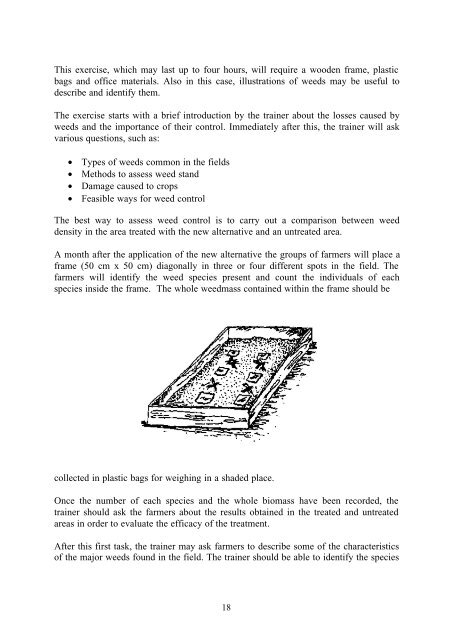Manual for Training of Extension Workers and Farmers on ... - DTIE
Manual for Training of Extension Workers and Farmers on ... - DTIE
Manual for Training of Extension Workers and Farmers on ... - DTIE
You also want an ePaper? Increase the reach of your titles
YUMPU automatically turns print PDFs into web optimized ePapers that Google loves.
This exercise, which may last up to four hours, will require a wooden frame, plastic<br />
bags <str<strong>on</strong>g>and</str<strong>on</strong>g> <str<strong>on</strong>g>of</str<strong>on</strong>g>fice materials. Also in this case, illustrati<strong>on</strong>s <str<strong>on</strong>g>of</str<strong>on</strong>g> weeds may be useful to<br />
describe <str<strong>on</strong>g>and</str<strong>on</strong>g> identify them.<br />
The exercise starts with a brief introducti<strong>on</strong> by the trainer about the losses caused by<br />
weeds <str<strong>on</strong>g>and</str<strong>on</strong>g> the importance <str<strong>on</strong>g>of</str<strong>on</strong>g> their c<strong>on</strong>trol. Immediately after this, the trainer will ask<br />
various questi<strong>on</strong>s, such as:<br />
• Types <str<strong>on</strong>g>of</str<strong>on</strong>g> weeds comm<strong>on</strong> in the fields<br />
• Methods to assess weed st<str<strong>on</strong>g>and</str<strong>on</strong>g><br />
• Damage caused to crops<br />
• Feasible ways <str<strong>on</strong>g>for</str<strong>on</strong>g> weed c<strong>on</strong>trol<br />
The best way to assess weed c<strong>on</strong>trol is to carry out a comparis<strong>on</strong> between weed<br />
density in the area treated with the new alternative <str<strong>on</strong>g>and</str<strong>on</strong>g> an untreated area.<br />
A m<strong>on</strong>th after the applicati<strong>on</strong> <str<strong>on</strong>g>of</str<strong>on</strong>g> the new alternative the groups <str<strong>on</strong>g>of</str<strong>on</strong>g> farmers will place a<br />
frame (50 cm x 50 cm) diag<strong>on</strong>ally in three or four different spots in the field. The<br />
farmers will identify the weed species present <str<strong>on</strong>g>and</str<strong>on</strong>g> count the individuals <str<strong>on</strong>g>of</str<strong>on</strong>g> each<br />
species inside the frame. The whole weedmass c<strong>on</strong>tained within the frame should be<br />
collected in plastic bags <str<strong>on</strong>g>for</str<strong>on</strong>g> weighing in a shaded place.<br />
Once the number <str<strong>on</strong>g>of</str<strong>on</strong>g> each species <str<strong>on</strong>g>and</str<strong>on</strong>g> the whole biomass have been recorded, the<br />
trainer should ask the farmers about the results obtained in the treated <str<strong>on</strong>g>and</str<strong>on</strong>g> untreated<br />
areas in order to evaluate the efficacy <str<strong>on</strong>g>of</str<strong>on</strong>g> the treatment.<br />
After this first task, the trainer may ask farmers to describe some <str<strong>on</strong>g>of</str<strong>on</strong>g> the characteristics<br />
<str<strong>on</strong>g>of</str<strong>on</strong>g> the major weeds found in the field. The trainer should be able to identify the species<br />
18
















